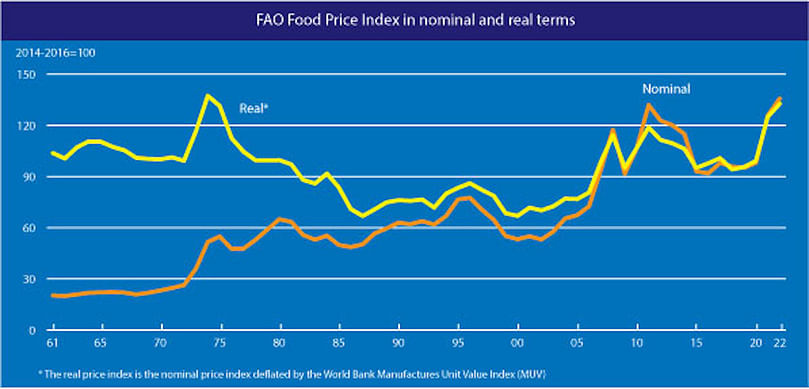Primaire tabs
FAO Food Price Index rebounded in January

The FAO Food Price Index* (FFPI) averaged 135.7 points in January 2022, 1.5 points (1.1 percent) higher than in December 2021.
The FFPI's rebound in January was led by solid gains in vegetable oils and dairy sub-indices, partially offset by a decline in sugar prices for the second consecutive month. Meat and cereal sub-indices remained largely unchanged.
The FAO Cereal Price Index averaged 140.6 points in January, up marginally (0.1 percent) from December and 15.6 points (12.5 percent) above its level one year ago. World wheat prices eased in January, down 3.1 percent, with increased seasonal supplies from large harvests in Australia and Argentina.
However, support from continued strong demand amidst tight global availability of higher-quality wheat along with uncertainty over exportable supplies, prevented prices from declining further.
By contrast, maize export prices were firmer in January, gaining 3.8 percent since December, mostly on concerns of persistent drought conditions in the southern hemisphere, namely Argentina and Brazil; spillover effects from the wheat market added upward pressure on maize prices.
Among other coarse grains, international sorghum prices also rose in January, in line with maize price trends, while barley quotations were slightly lower.
The completion of main-crop harvests in major suppliers and purchases by Asian buyers also raised international rice prices in January by 3.1 percent.
The FAO Vegetable Oil Price Index averaged 185.9 points in January, up 7.4 points (4.2 percent) month-on-month, marking an all-time high. The rise reflected higher quotations for palm, soy, rapeseed and sunflowerseed oil.
After a short-lived drop, international palm oil prices rebounded in January, largely underpinned by concerns over a possible reduction in export availabilities from Indonesia, the world's top palm oil exporter, as well as subdued output in key producing countries.
World soyoil prices also recovered, supported by robust import purchases, particularly from India.
In the meantime, rapeseed and sunflowerseed oil prices were buoyed by, respectively, lingering supply tightness and surging global import demand. Rising crude oil prices also lent support to international vegetable oil values.
The FAO Dairy Price Index averaged 132.1 points in January, up 3.1 points (2.4 percent) from December 2021, marking the fifth consecutive monthly increase, and placing the index 20.8 points (18.7 percent) above its value in the corresponding month last year.
In January, price quotations for dairy products rose, with the steepest increases in skim milk powder and butter.
The January increase was underpinned by a tightening in global markets, reflecting a reduction in export availabilities, especially from Western Europe, where a reported reduction in milk deliveries in some large milk-producing countries and lower stock levels supported prices.
Expectations for milk production in Oceania to remain below its average levels in the months ahead added to the tightening in global dairy markets. In addition, milk processing and transportation delays due to COVID-19-related labour shortages further contributed to higher dairy prices.
The FAO Meat Price Index* averaged 112.6 points in January, up slightly from December 2021, and lifting the index value 16.6 points (17.3 percent) above its corresponding month a year ago.
In January, bovine prices reached a new peak, underpinned by strong global import demand exceeding export supplies, mainly from Brazil and Oceania, reflecting lower cattle supplies for processing.
Meanwhile, pig meat quotations rose slightly, as labour shortages and high input costs dampened global supply, countering the downward pressure from China's slowdown in imports.
By contrast, ovine and poultry meat prices softened further, as global exportable supplies outstripped import demand, despite constrained supplies stemming from COVID-19-related production and transportation delays, and avian flu outbreaks in some large poultry meat producing countries.
The FAO Sugar Price Index averaged 112.8 points in January, down 3.7 points (3.1 percent) from December, marking the second consecutive monthly decline and the lowest level in the past six months.
The January decline in international sugar price quotations was mostly related to favourable production prospects and good harvest progress in major exporters, India and Thailand, and improved rains in key growing areas of Brazil.
In addition, lower ethanol prices in Brazil exerted further downward pressure on world sugar prices in January. However, the strengthening of the Brazilian Real against the US Dollar, which tends to restrain shipments from Brazil, the world's largest sugar exporter, prevented more substantial sugar price declines.
* Unlike for other commodity groups, most prices utilized in the calculation of the FAO Meat Price Index are not available when the FAO Food Price Index is computed and published; therefore, the value of the Meat Price Index for the most recent months is derived from a mixture of projected and observed prices. This can, at times, require significant revisions in the final value of the FAO Meat Price Index which could in turn influence the value of the FAO Food Price Index.










